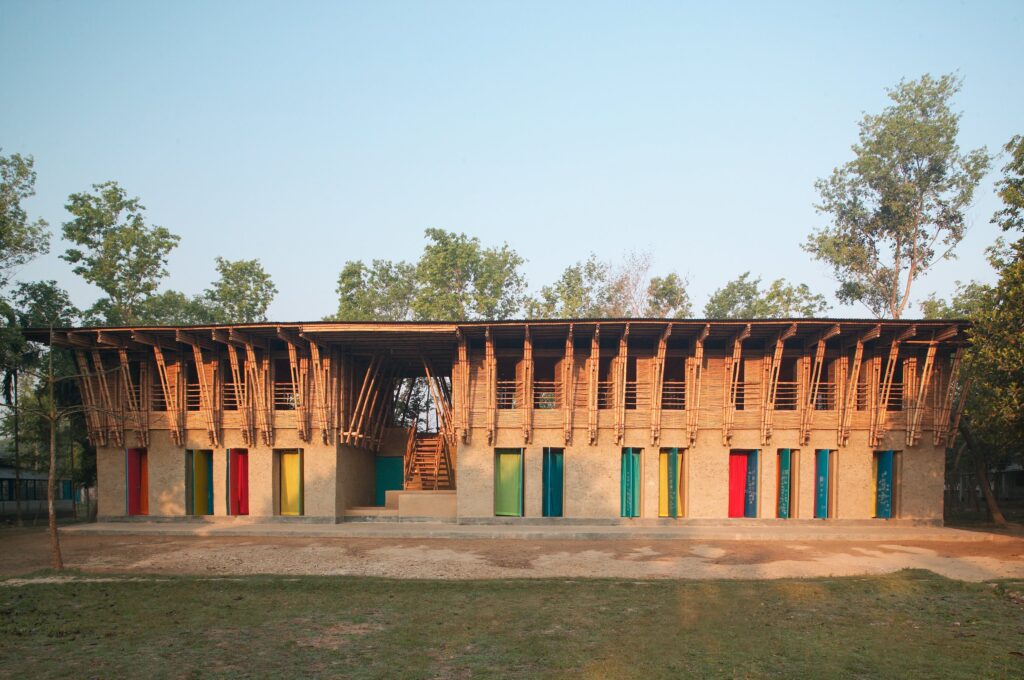
Project goal
The philosophy of METI (Modern Education and Training Institute) is learning with joy. The teachers help the children to develop their own potential and to use it in a creative and responsible way. The building reflects these ideas in terms of materials, techniques, and architectural design. The aim of the project is to improve existing building techniques, to contribute to sustainability by utilising local potential, and to strengthen regional identity.
Context
Bangladesh is a fertile alluvial land in the Gulf of Bengal and the land with the highest population density in the world. On average, nearly 1000 people live in every square kilometre and over 80% of the population live in rural areas. Much of the vernacular built tradition uses earth and bamboo as a building material; however, construction techniques are error-prone and many buildings lack foundations and damp-proof coursing. Such buildings require regular maintenance, are often prone to damage and last, on average, only 10 years.

Project aims
It is particularly important to improve the quality of living in rural areas to counteract the continuing population migration to cities. The primary potential for developing buildings in rural areas is the low cost of labour and locally available resources such as earth and bamboo.
The project’s main strategy is to communicate and develop knowledge and skills within the local population so that they can make the best possible use of their available resources. Historic building techniques are developed and improved, and the skills are passed on to local tradespeople, transforming, in the process, the image of the building techniques.
Concept and Design
METI aims to promote individual abilities and interests, taking into account the different learning speeds of school children and trainees, in a free and open form of learning. It offers an alternative to the typical frontal approach to lessons. The architecture of the new school reflects this principle and provides different kinds of spaces and uses to support this approach to teaching and learning.
On the ground floor with its thick earth walls, three classrooms are located each with their own access opening to an organically shaped system of ‘caves’ to the rear of the classroom. The soft interiors of theses spaces are for touching, for nestling up against, for retreating into exploration or concentration, on one’s own or in a group.
The upper floor is by contrast light and open, the openings in its bamboo walls offering sweeping views across the surroundings, its large interior providing space for movement. The view expands across the treetops and the village pond. Light and shadows from the bamboo strips play across the earth floor and contrast with the colourful materials of the saris on the ceiling.
Building construction and techniques
The building rests on a 50 cms deep brick masonry foundation rendered with a facing cement plaster. Bricks are the most common product in Bangladesh’s building manufacturing industry. Bangladesh has almost no natural reserves of stone and as an alternative, the clayey alluvial sand is fired in open circular kilns into bricks. These are used for building or are broken down for use as aggregate for concrete or as ballast chippings. Imported coal is used to fire the kilns.
Aside from the foundation, the damp-proof course was the other most fundamental addition to local earthen-building skills. The damp-proof course is a double layer of locally available PE film. The ground floor is realised as load-bearing walls using a technique similar to cob walling. A straw-earth mixture with a low straw content was manufactured with the help of cows and water buffalo and then heaped on top of the foundation wall to a height of 65 cm per layer. Excess material extending beyond the width of the wall is trimmed off using sharp spades after a few days. After a drying period of about a week, the next layer of cob can be applied. In the third and fourth layers, the door and window lintels and jambs were integrated, as well as a ring beam made of thick bamboo canes as a wall plate for the ceiling.
“It was good to do tests and experiments together before starting the real construction, so we could understand it although we did not know the language. And everybody learnt a lot from each other. I learned how to build strong walls, how to use measurement tools, and the foreigners learnt that the best mixing machines are water buffalos.”
Suresh, loam worker, Rudrapur, Bangladesh
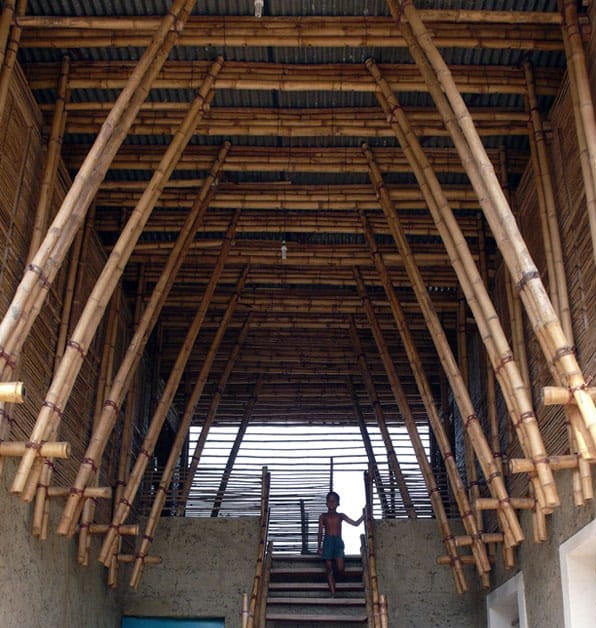
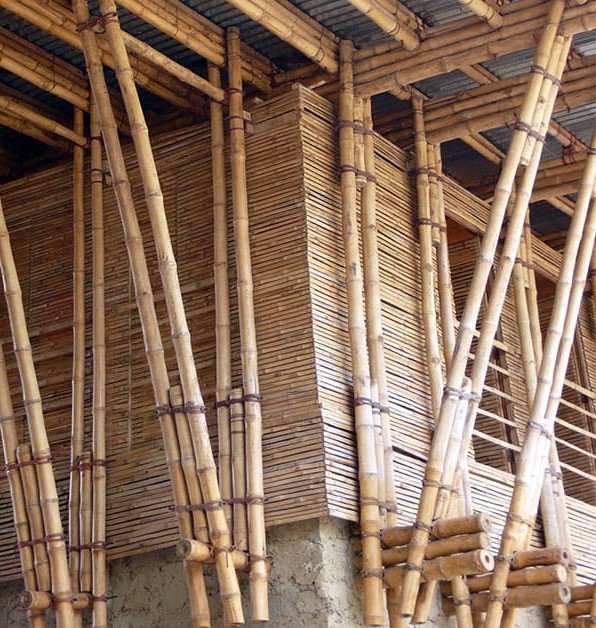

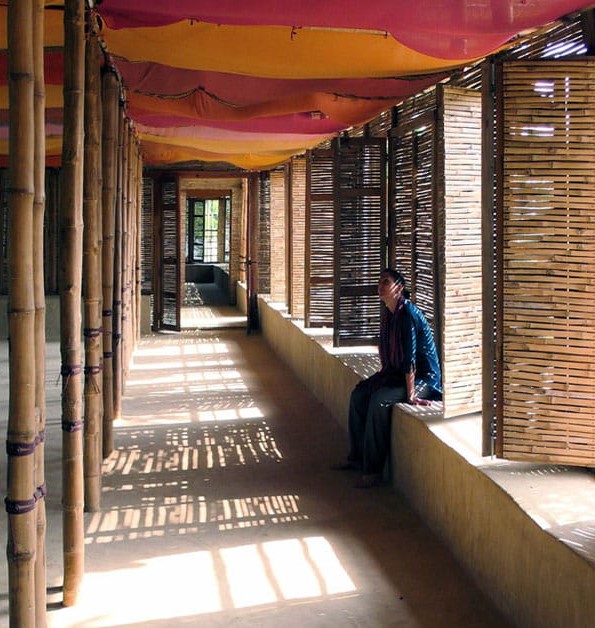
The ceiling of the ground floor is a triple layer of bamboo canes, with the central layer arranged perpendicular to the layers above and beneath to provide lateral stabilisation and a connection between the supporting beams. A layer of planking made of split bamboo canes was laid on the central layer and filled with the earthen mixture analogue to the technique often used in the ceilings of European timber-frame constructions.
The upper storey is a frame construction of four-layer bamboo beams and vertical and diagonal members arranged at right angles to the building. The end of the frames at the short ends of the building and the stairs also serve to stiffen the building. These are connected via additional structural members with the upper and lower sides of the main beams and equipped with additional wind bracing on the upper surface of the frame. A series of bamboo rafters at half the interval of the frame construction beneath provide support for the corrugated iron roof construction and are covered with timber panelling and adjusted in height to provide sufficient run-off.
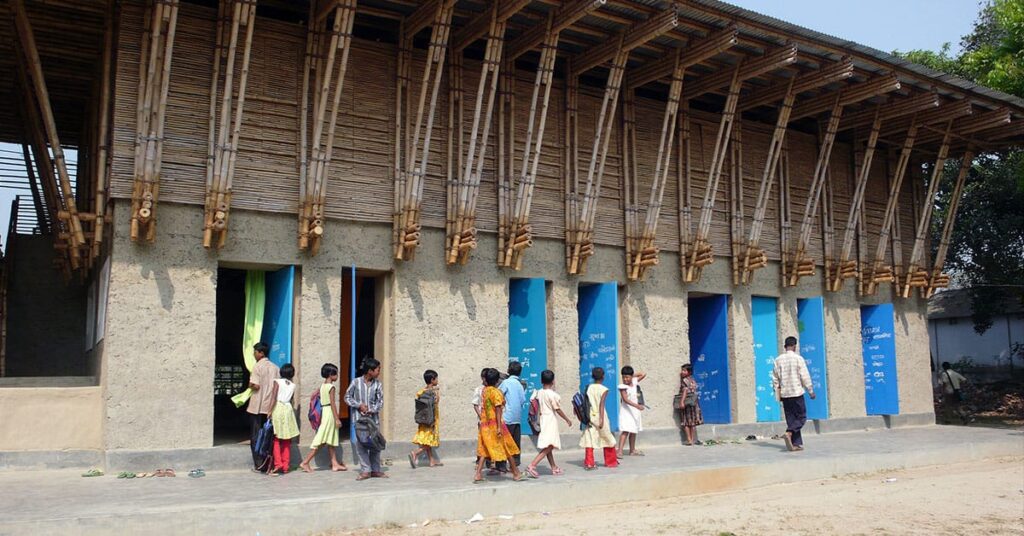
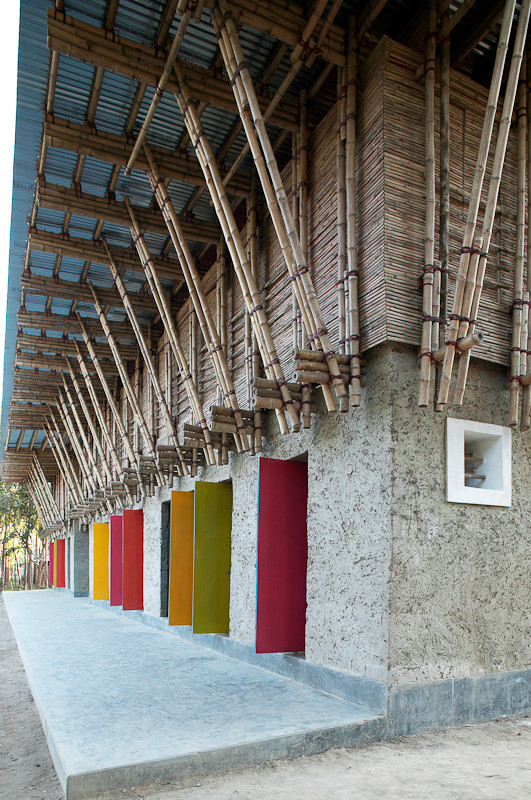
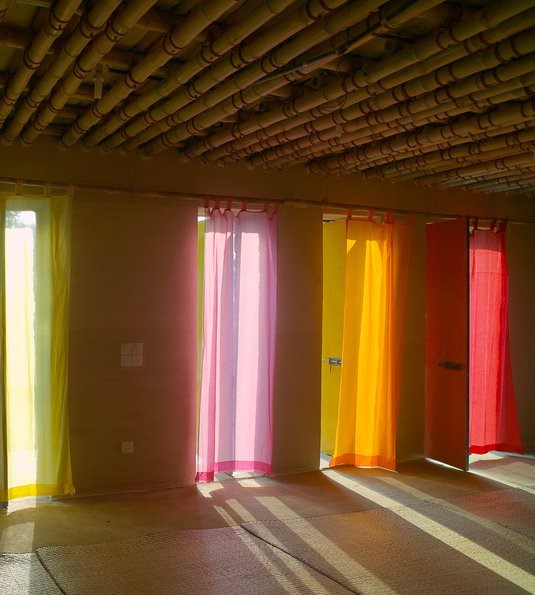
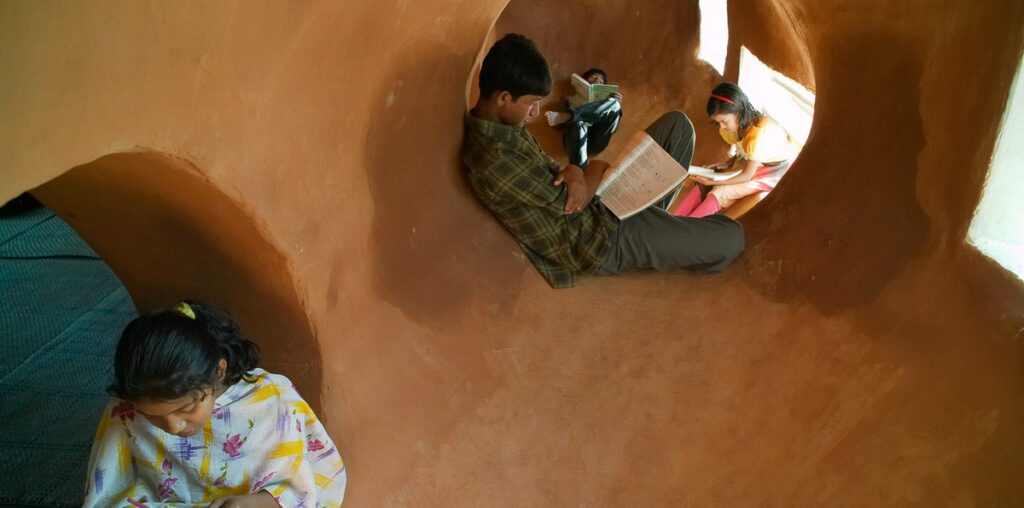
“We already feel that this new ideas of the METI building have raised hope and confidence for an improvement of living conditions for the poor in our rural areas.”
Paul Tigga, project partner and CEO, Dipshikha, Bangladesh
The entire budget for the school construction remained within the village and the direct surroundings; the building materials, earth and bamboo, were all local, as were the construction workers. The construction workers were day labourers from the village of Rudrapur. During the construction process, they were trained in improved earth- and bamboo construction techniques. The building techniques were chosen in order to be able to be replicated by the local people and to have a positive effect on the existing, poor housing situations. The school kids were involved in the building process as well to learn the value of sustainable construction and to reflect on it.
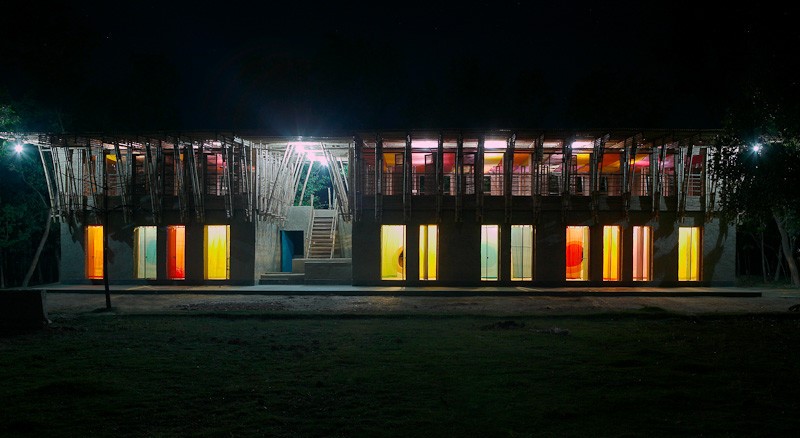
Project Drawings:
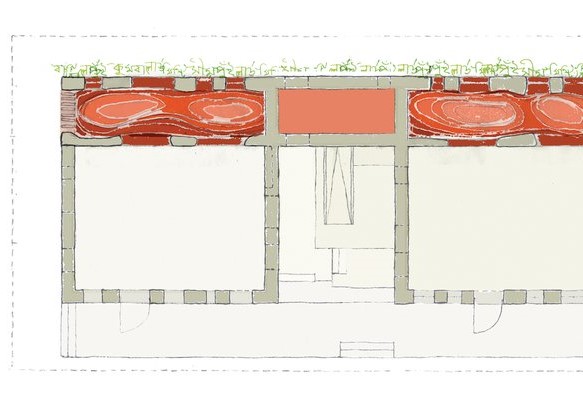



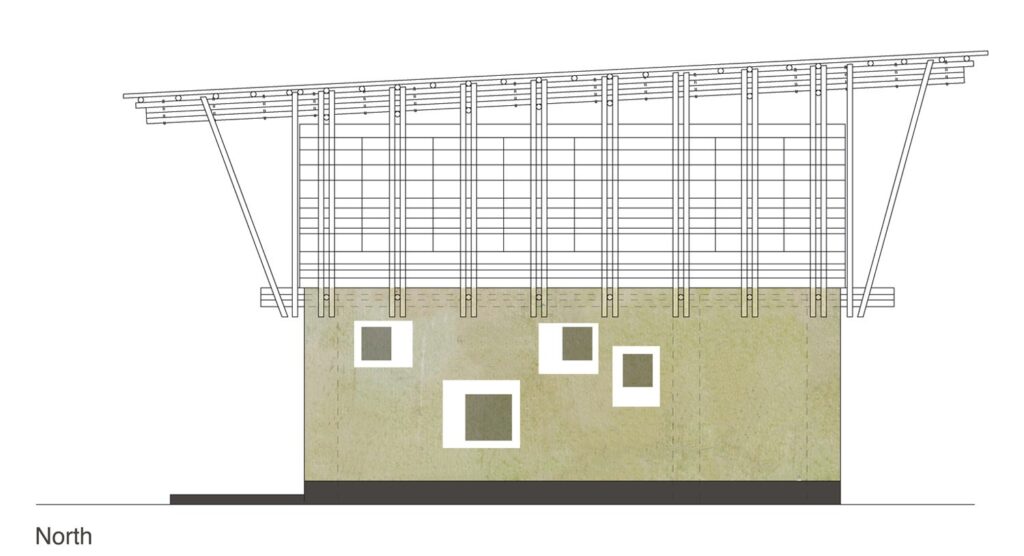

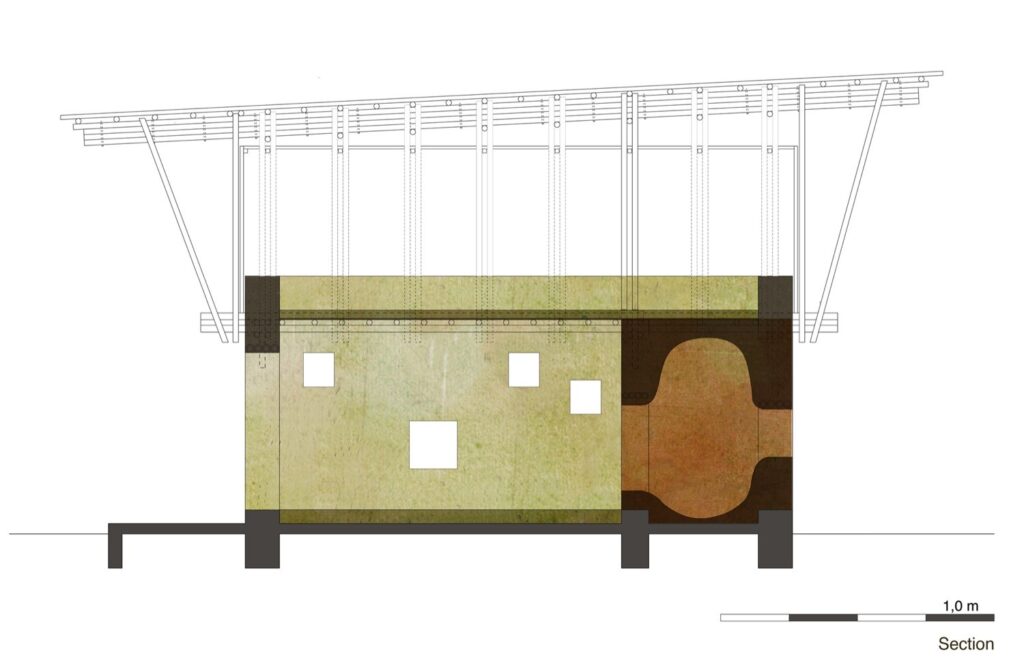
Project Details:
Name: METI (Modern Education and Training Institute) School or Handmade School
Location: Rudrapur, Dinajpur district, Bangladesh
Area: 325 sq. mts.
Year: Built (2006)
Clients: Dipshikha, Bangladesh
Designed by: Anna Heringer (Design and Concept) and Eike Roswag (Technical planning)
Construction core team (Bangladesh): Raboti Roy, Nikhil Chandra Roy, Buden Chandra Roy, Aminul Islam, Apon Chandra Roy, Suresh Chandra Roy, Jitendra Nath Roy, Sonjib Roy, Satish Chandra Roy, Romesh Roy, Fatik Roy, Bimol Roy, Bimol Roy, Upendra Nath Roy, Khokendra Nath Roy, Susen Roy, Vhomol Chandra Roy
Construction team (Austria/ Germany): Emmanuel Heringer, Stefanie Heringer, Christiane Liebert, Christine Karl, Clemens Bernhardt, Michael Bitto, Ursula Nikodem-Edlinger-Holzinger, Cornelia Reithofer, Veronika Reithofer, Kurt Horbst
Consultants:
Structural engineering, Earth construction consulting: Dr. Christof Ziegert, Uwe Seiler
Consulting, building supervision and training of workers in bamboo construction: Emmanuel Heringer (basket weaver and carpenter), Stefanie Haider (blacksmith)
Landscape architecture: Khondaker Hasibul Kabir, Abdun Nime
Further consulting: Prof. Roland Gnaiger (supervision design), Peter Kugelstatter, Rudolf Sackmauer (structural engineering), Martin Rauch (earthen structures), Oskar Pankratz (climate engineering)
Photographs: Kurt Hoerbst






